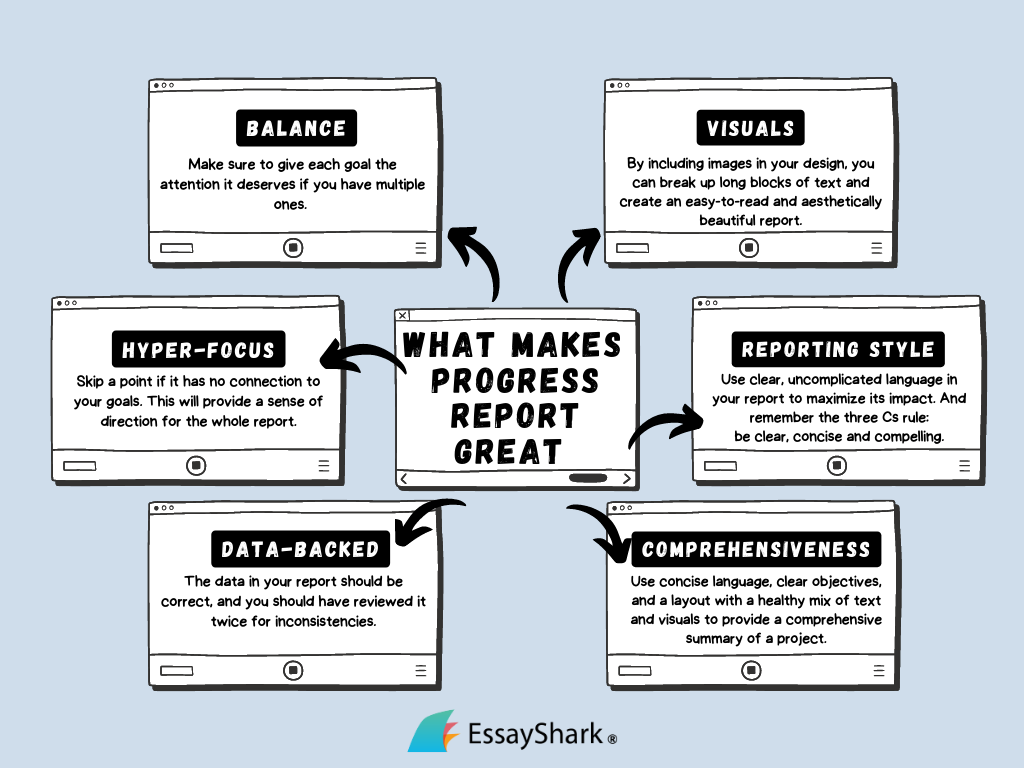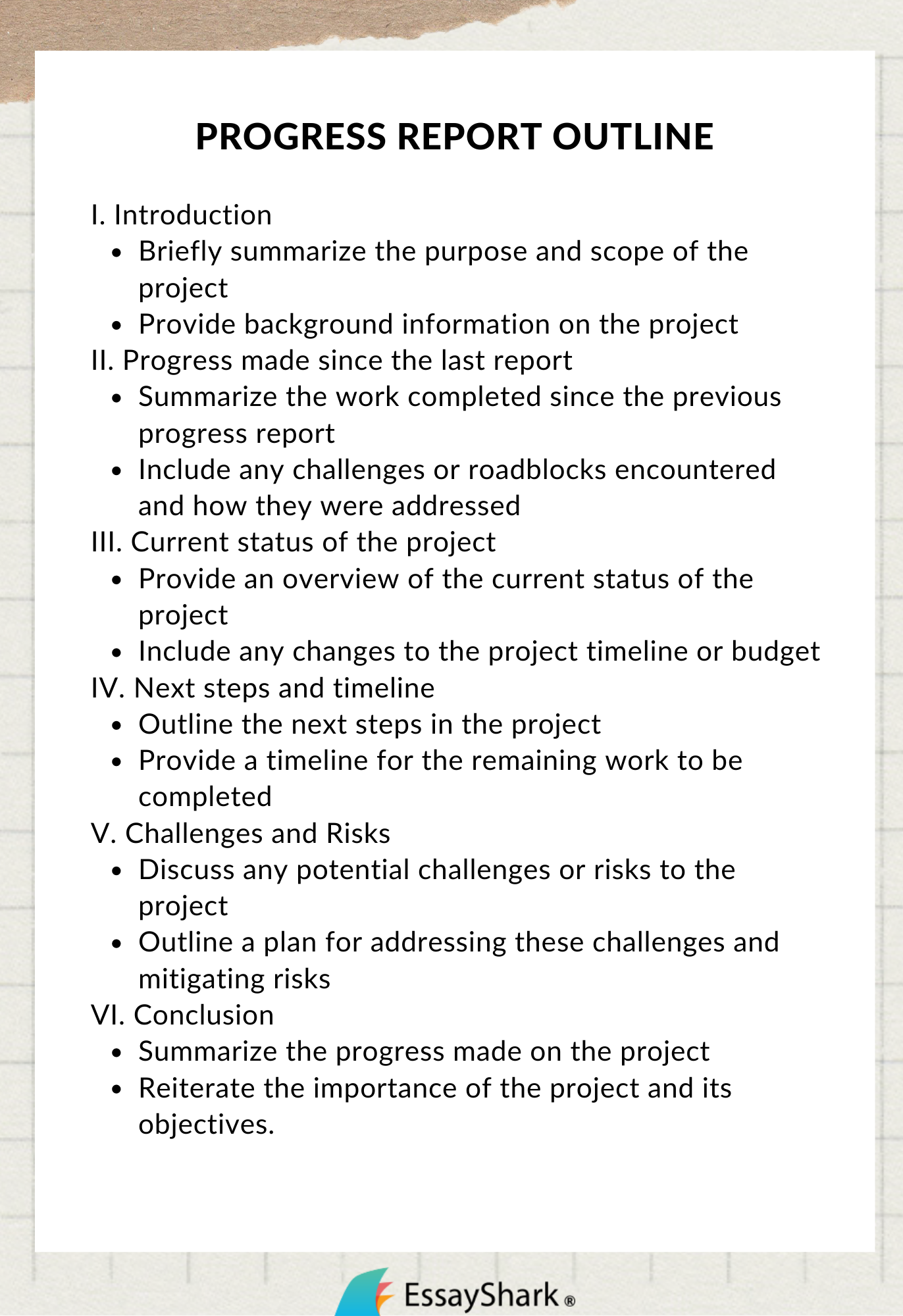
When to write a progress report
Progress reports are typically prepared on a regular schedule, such as monthly or quarterly. However, depending on the project’s needs, they may also be designed as needed. Progress reports may have a structure of “write my PowerPoint presentation” docs or be organized like “write my personal statement” assignments. One can prepare a progress report at the end of each project phase or after each milestone.
Format for progress report
There is no one-size-fits-all format for the progress report. However, there are a few elements that require to be included in all reports:
- The title of the project.
- The names of the parties involved in the project.
- The date of the report.
- A summary of the project’s progress to date.
- A description of the work completed since the last progress report.
- A description of the work planned for the next period.
- Financial information, such as budget and revenues.
- Risk and challenges assessment.
- Any other relevant information.
Once you have gathered all the information to include in the progress report, you can begin to format it. Begin by creating a title page, which should include the title of the project, the date, and the names of the parties involved.
Next, create a table of contents to help readers navigate the report. (Feel free to check our narrative essay outline example for a better idea of what tables of contents, aka document plans look like.) Then, begin the body of the information with an executive summary, which should provide an overview of the project’s progress.
After the executive summary, provide a detailed account of the project’s progress. Include information on completed, planned work and any challenges or risks. Finally, conclude the report with a financial overview, including budget information, revenue, and expenses.

With these tips, you’re ready to write a progress report to keep your stakeholders informed and your project on track.
Steps for writing a progress report
A progress report is a written update on the progress made on a project. It is typically used to update the project manager or client. Progress reports are also used to track the progress of individual team members.
The following is a guide on how to write a progress report.
Step 1: Determine the purpose of the progress report
The progress report can be used for various purposes, such as to inform the project manager or client of the project’s status, track the progress of individual team members, or assess the project’s overall progress.
Step 2: Gather the necessary information
So, how to make a progress report? To write a progress report, you will need data on the project’s progress, which can include information on milestones that have been achieved on the project, tasks that have been completed, and any problems that have arisen. Think of it as a research step you take for write my term paper and write my dissertation assignments: First, you need data and other evidence to support your claims; then, you have all the information to organize into a document.
Step 3: Write the report
Reports should be clear and concise. They should also be free of any grammar or spelling errors. Be sure to include the date of the report, as well as the dates that the progress being reported covers.
Step 4: Submit the report
Progress reports should be submitted to the project manager or client regularly. Depending on the project, this could be weekly, bi-weekly, or monthly. It is essential to be clear and concise when writing a progress report. The report should also be free of any grammar or spelling errors.
Progress report writing steps infographic
Have you understood all the tips? Then move on to the six steps to write a progress report and afterward you will complete your paper easily!

Tips to write an excellent progress report
No matter your project’s stage, you must take the time to write a progress report. You can effectively communicate your project’s current status to your boss, colleagues, or client. But what exactly should you include in a progress report? And what’s the best format to use?
Continue reading for a detailed guide on writing a progress report. The guide will include some crucial tips for generating an excellent progress report. These tips will also come in handy for any other write my assignment tasks you might get from teachers at school or colleagues at work. Progress reports are an essential part of any project. You can effectively communicate your project’s status to your boss, colleagues, or client by writing an efficient progress report. But what exactly should you include in a progress report? And what’s the best format to use?
Here are some tips on what to include in a progress report:
- A clear overview of the project’s current status.
- A detailed list of what has been accomplished.
- A list of any issues or risks that have arisen.
- A plan for how to address any issues or risks.
- A forecast of what will be performed in the next reporting period.
Now that you know how to write a progress report, put these tips into practice the next time you need to communicate project status to your boss, colleagues, or client.
Use a clear format
When writing a progress report, it’s essential to use a clear and concise format. Stick to the facts and avoid adding any unnecessary details. If you checked our guide on how to write an academic film review, you might get a general idea of straightforward formatting for such types of formal documents. The progress report definition is to give your reader a clear overview of the project’s current status and accomplishments.
Here’s a suggested format for a progress report:
- Executive summary